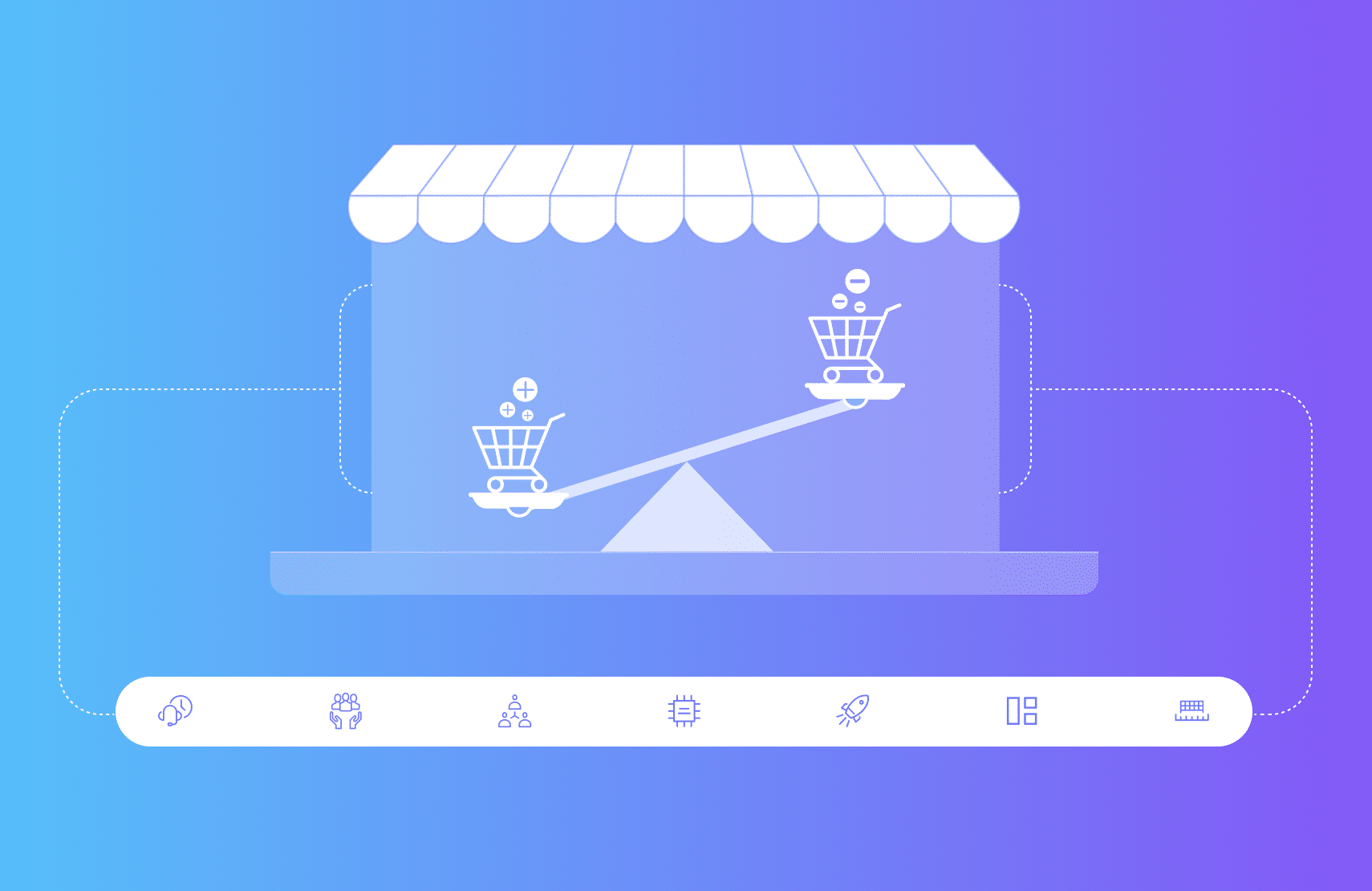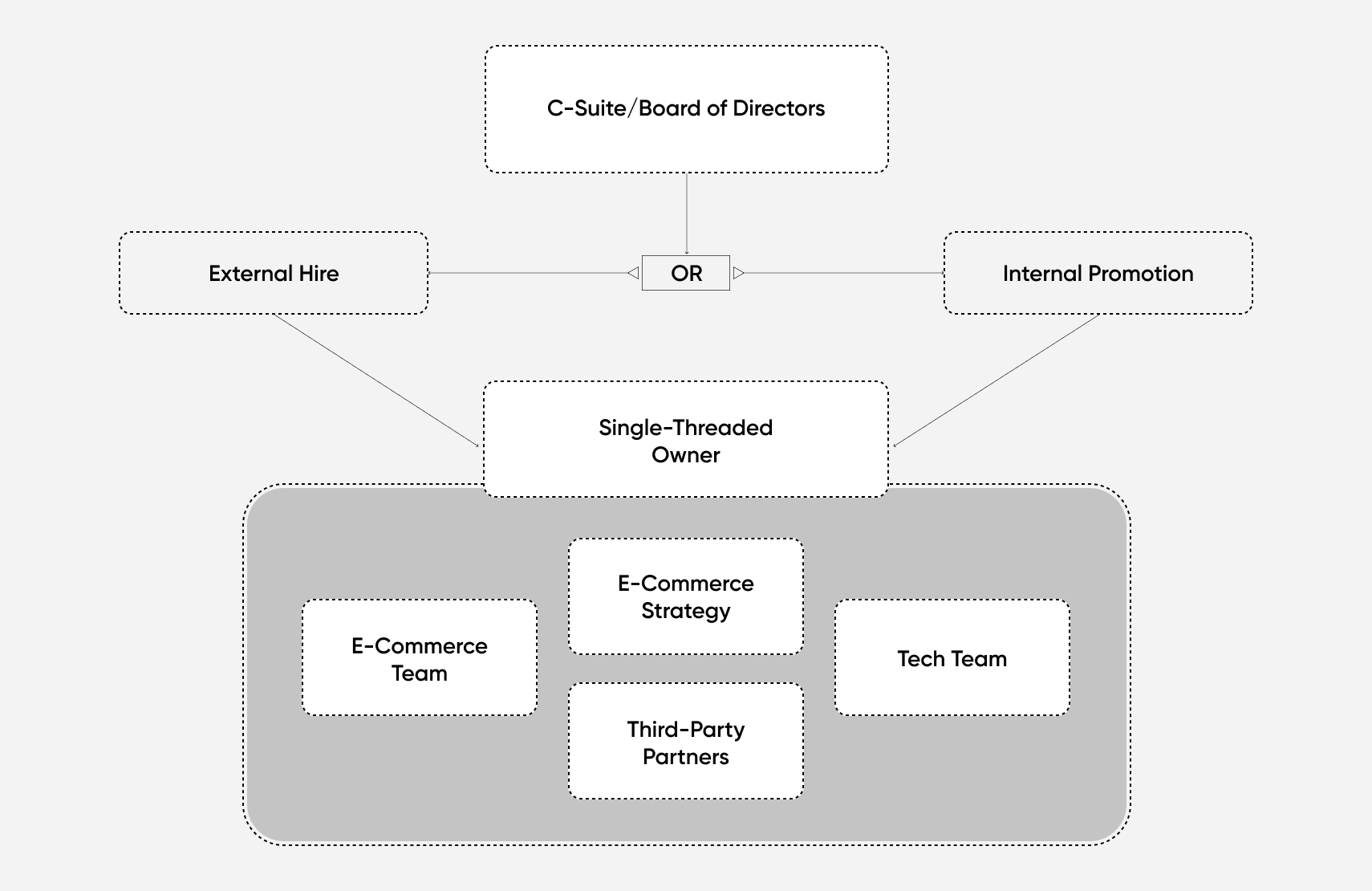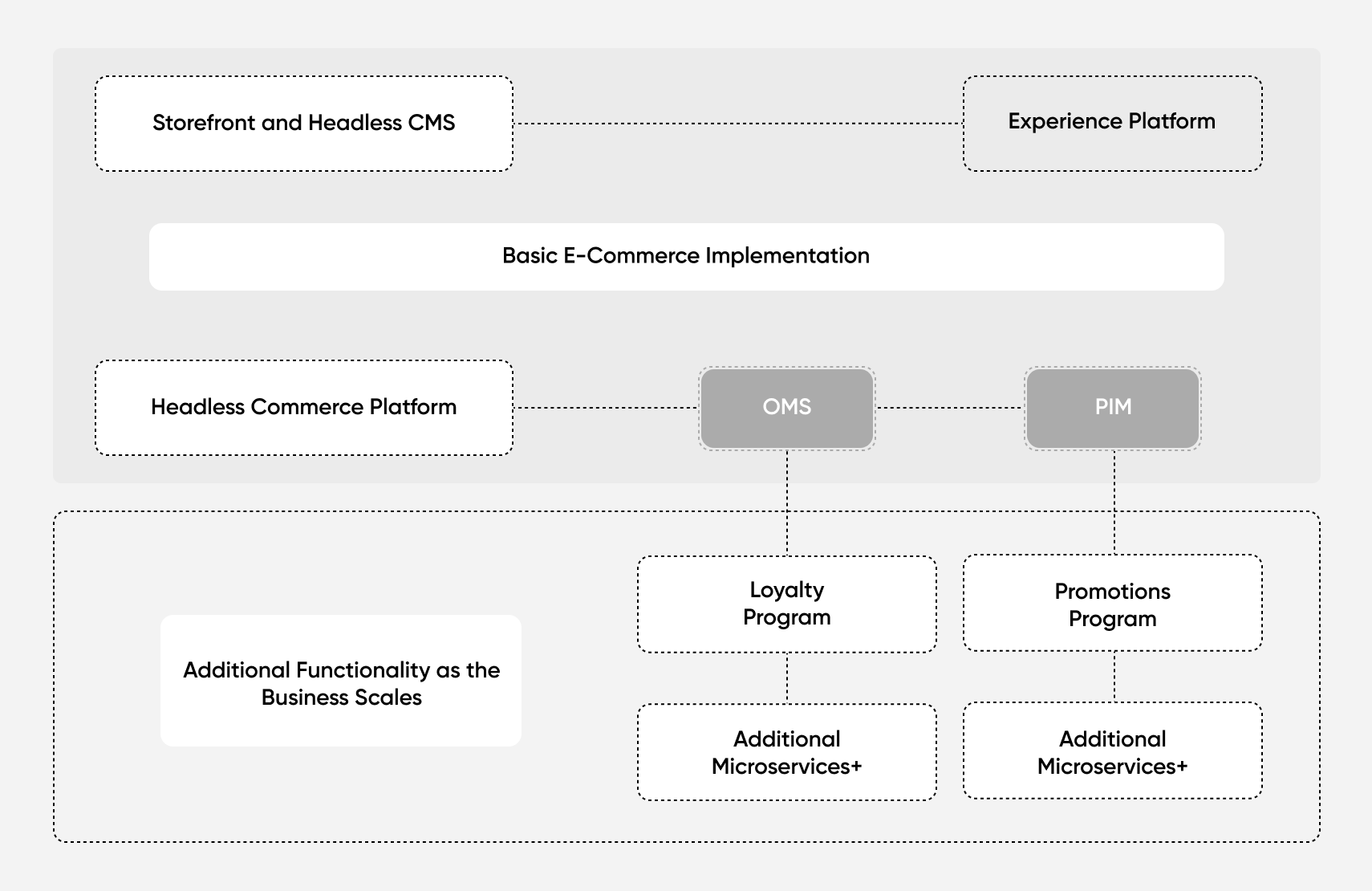Advantages and Disadvantages of E-Commerce for Enterprises

Enterprises need to weigh e-commerce advantages and disadvantages to influence and inform their approach to developing and launching an e-commerce store.
Support from C-level executives and the board of directors plays a crucial role in how e-commerce benefits business goals, growth, and scalability.
Though the organization’s leadership should be fully involved in its e-commerce strategy, the responsibility of implementing that strategy should be delegated to an autonomous single-threaded owner.
A headless commerce platform like fabric Commerce provides enterprises with the advantages of e-commerce using a convenient, flexible, and scalable microservice-based architecture.
E-commerce is booming. Retail e-commerce sales grew by 32.4% in 2020, propelled by the COVID-19 pandemic and subsequent lockdowns and safety concerns that led more shoppers to buy online. Though its growth rate is slowing compared to the pandemic period, e-commerce is still projected to grow by 17.9% in 2021, continuing to increase until at least 2025.
Even without the pandemic’s effect on sales, e-commerce has contributed to the success and rise of many major brands. Retailers like Warby Parker leveraged the advantages of e-commerce to achieve unicorn status and secure a market cap in the billions. Throughout 2021, other brands, including Apple and Chewy, increased e-commerce sales by 25.7% and 25%, respectively.
Despite its benefits, there are disadvantages to e-commerce, too. Inadequate e-commerce strategies risk increasing the total cost of ownership (TCO) of developing and launching an e-commerce store, as is the case with Macy’s or grocers like Kroger, the latter of which saw sales decline by 3.1% in 2020.
The advantages and disadvantages of e-commerce depend on the quality and consistency of support provided by a brand’s executives and board.
[toc-embed headline=”E-Commerce Considerations: Advantages and Disadvantages”]
E-Commerce Considerations: Advantages and Disadvantages
How e-commerce benefits business depends on a business’s approach. Some brands leverage e-commerce to provide buy online, pick up in-store (BOPIS) functionality. Others, like Pier 1, have shifted entirely to e-commerce, demonstrating that even older retailers can embrace the advantages of e-commerce.
But before shifting to an e-commerce model, retailers need to weigh the pros and cons of e-commerce to avoid incurring technical debt and sending the TCO skyrocketing.
| Consideration | Advantage | Disadvantage |
| Provide long-term support | It empowers the e-commerce team with autonomy and ongoing investment directly from the top of the organization. | It requires significant attention from the C-suite and BoD, as well as required capital and technology. |
| Nurture team members | A talented and dedicated team under the supervision of a fully autonomous single-threaded owner prioritizes company goals. | Hiring outside expertise may lead employees to feel as if they were “passed over” and competitive salaries and benefits may be costly. |
| Develop a tech team | An in-house tech team aligns with an organization’s goals on both a short- and long-term basis. | Outsourcing to a system integrator may be simpler and more affordable than developing an in-house team. |
| Keep tech simple | It avoids incurring technical debt by using flexible architecture that enables future growth without replatforming. | Not all features may be immediately available out of the box, necessitating future development or integration. |
| Launch fast, iterate later | Implementing an e-commerce solution quickly begins bringing in an additional source of revenue. | It pulls resources and funding from other projects in the lead-up to launch and as bugs and issues are ironed out. |
| Nail the basics | It establishes an initial framework of an e-commerce solution without unnecessary or complex features and functionality at the outset. | A barebones structure requires additional work and development to add necessary or desired features and functionality. |
| Measure input goals | It lets the team measure and take ownership of actions they are directly responsible for and can impact through their work. | Input goals don’t always provide the most comprehensive performance overview. |
Provide long-term support
E-commerce is a long-term investment. Continued support from the entire organization—including the C-suite and board of directors—is critical to the success or failure of an enterprise e-commerce strategy. C-level executives must play an active role in implementing, managing, and supporting the initiative.
CEOs, especially, must define how e-commerce benefits business even if they take a largely hands-off approach from implementing a digital pivot. To accomplish this, they must actively fight for the necessary resources to successfully launch an e-commerce project, including funding, human resources, technology, and third-party partnerships.
Advantages:
- Support from the top of the organization ensures that the e-commerce team has adequate resources at its disposal.
- Empowering the e-commerce team with lasting and direct support from the organization’s leadership frees the team from arbitrary and unproductive waiting periods pending approval from above.
Disadvantages:
- Senior leadership must invest significant amounts of time and resources into developing and implementing an e-commerce strategy and team.
- Treating an e-commerce strategy as a long-term investment vs. a project requires commitment and doesn’t guarantee immediate or timely results.
Nurture team members
A company’s leadership should maintain oversight and active involvement in its e-commerce strategy, but should also assign ownership of the initiative to a dedicated manager. This single-threaded owner (STO) may or may not be a C-level executive, which means brands may want to consider looking elsewhere—including both internally or externally—to find a leader with the necessary experience.
Ultimately, the STO must be someone who is held fully accountable for seeing a brand’s e-commerce implementation through from ideation to completion. This includes developing and nurturing a team of experienced individuals who are well-equipped to handle the task before them. Though some employees may be repurposed and reassigned to the e-commerce initiative, the STO—supported by the C-suite and BoD—must be empowered to recruit external expertise.

Diagram: The C-suite and board of directors appoint a single-threaded owner—either an external hire or internal promotion—with the sole responsibility of seeing an e-commerce strategy implemented from start to finish.
Advantages:
- An STO’s sole responsibility is deploying an e-commerce strategy and building and nurturing a team of experts that enables its success.
- Having a leader and specialized team focused entirely on a brand’s e-commerce initiative provides flexibility and the ability to rapidly deploy and continually iterate on an e-commerce architecture.
Disadvantages:
- It takes time for external hires, including the role of STO, to understand the company culture.
- Seventy-one percent of employees prefer working with internal hires when scaling a business.
Develop a tech team
A brand’s e-commerce team relies, in part, on a tech team for sourcing, deploying, and maintaining its e-commerce infrastructure. Enterprises often outsource this work to system integration (SI) firms that take on the complex task of ensuring disparate pieces of tech work together seamlessly. However, an SI team may prioritize its own goals ahead of your own by padding its billing hours or spending too many hours on individual projects.
In contrast, an in-house team, under the supervision of the STO and with the support of the C-suite, shares the brand’s goals. With this structure, decisions can be made to use a versatile and headless platform like fabric Commerce rather than a monolithic framework that may require costly and time-consuming replatforming as the brand scales.
Advantages:
- Outsourced SI firms specialize in building, deploying, and maintaining e-commerce infrastructure, potentially allowing for a quick launch.
- An in-house tech team may align closely with the company’s goals, ensuring smoother and future-proofed implementation.
Disadvantages:
- An outside SI firm may not fully align with a brand’s goals and may focus primarily on billable hours rather than continued progress.
- In-house tech teams may not be as immediately agile or skilled with available technologies, necessitating continued training and reskilling.
Keep tech simple
E-commerce advantages and disadvantages often hinge on a brand’s choice of retail management software for its e-commerce functionality. It’s this architecture that dictates whether a brand can excel at a multi-channel approach or fall flat on its face with a TCO spiraling out of control.
Monolithic platforms like Oracle or Magento are sometimes considered safe choices at the outset but necessitate costly and lengthy development time when it comes time to scale. Instead, enterprises should leverage microservice-based architecture that lets brands deploy e-commerce solutions quickly while supporting future scalability.
Advantages:
- Flexible e-commerce software provides a framework that can be easily expanded upon via tailored microservices without requiring significant development time.
- Microservice-based architecture supports multi-channel commerce without requiring complex and time-consuming workarounds or custom solutions to integrate.
Disadvantages:
- Monolithic platforms are simple and convenient to implement and launch but are rigid and difficult to scale as a brand grows.
- Replatforming from a monolith to microservices requires careful planning and a long development and deployment cycle.
Launch fast, iterate later
One of the keys to understanding how e-commerce benefits business is the idea that something is better than nothing. Though new e-commerce businesses can be launched in under four months, it may take between six and nine months for a complete launch—or longer, if an enterprise is more reliant on outside support than in-house.
This timeline can be shortened by leveraging technology, such as a headless CMS. From there, an enterprise can build upon its e-commerce initiative through application programming interfaces (API) that integrate disparate services into a single ecosystem, expanding functionality and helping the company improve its e-commerce offering.
Advantages:
- Launching fast lets enterprises start selling almost immediately, using traffic and other sales data to influence future iteration.
- Headless e-commerce software is versatile and enables enterprises to continually scale and evolve through microservice-based architecture.
Disadvantages:
- Launching fast may result in a barebones e-commerce store without providing all the benefits of e-commerce to customers.
- The initial launch may require a significant upfront investment of resources (including funds and personnel) that are drawn from other areas of the business.
Nail the basics
A brand’s e-commerce solution can be an expansive, feature-packed behemoth, but that shouldn’t be the priority at launch. Instead, enterprises need to focus on perfecting the fundamentals before adding additional features and functions.
Initial focus should be given to implementing basic and necessary features, such as a product information manager (PIM) and order management system (OMS). From there, the development team should improve site speed and mobile accessibility before introducing new and complex features.

Diagram: Enterprises should prioritize implementing and perfecting the basics of an e-commerce storefront before improving functionality through additional microservices, APIs, and features.
Advantages:
- Focusing on the basics first lets enterprises fix bugs, iron out issues, and establish a strong framework for future growth and scaling.
- Launching with a basic structure helps the e-commerce and tech teams better plan for rolling out additional functionality based on simple but tangible results.
Disadvantages:
- The e-commerce and tech team may not feel as busy without continually working on implementing new features and functionality.
- Nailing the basics ignores some benefits provided by e-commerce features, such as personalization and promotions capability.
Measure input goals
Input goals are goals that are directly actionable by an enterprise e-commerce and tech team. Unlike output goals—which measure metrics such as revenue and market share—input goals help teams react and respond to the changing needs of an e-commerce strategy.
For example, a high cart abandonment rate may illustrate an issue with the checkout experience. The input goal of decreasing the abandonment rate could be impacted by changing aspects of the checkout process, such as allowing guest checkout or by implementing an address verification service (AVS).
Advantages:
- Prioritizing input goals lets an e-commerce team ignore metrics they have no direct control of, focusing instead on ways they can improve performance.
- Tech teams that focus on input goals shift responsibility for external output goals to those responsible for directing the overall e-commerce strategy (such as the STO and C-suite).
Disadvantages:
- Without frequent consideration of output goals and performance, it may be easy to lose sight and track of the bigger picture and overall company goals.
- Without the context of output goals, input goals aren’t entirely indicative of an e-commerce store’s performance.

Tech advocate and writer @ fabric.